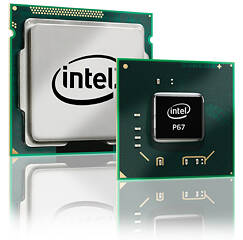 0
0
ECS P67H2-A2 (B3) Review
Packaging & Contents »Intel P67 Chipset

A few short months ago, Intel launched their latest platform, codenamed SandyBridge. Shortly after release the majority of motherboard chipsets were recalled by Intel for a revision, and today, all of those products are back on the store shelf, and not without a bit of fanfare. Manufacturer packaging lauds the inclusion of the latest revision of Intel's P67 chipset, the B3 stepping, and with good reason, as this indicates that the chipset's SATA drive controller will survive throughout the warranty period.

The above block diagram shows basic layout and functionality of Intel's P67 chipset. Supporting four SATA2 channels and two SATA 6 Gb/s channels natively, it offers full functionality and speed for both internal drives as well as for external drives over eSATA and USB3.0, thanks to a full-speed PCIe 2.0 implementation integrated directly into the CPU and chipset. In fact, the P67 chipset merely serves as a basic input/output hub, with the majority of features previously relegated to the chipset now fully integrated within the CPU silicon itself. This serves to provide high-speed, low latency throughput, but at the same time, does limit expansion possibilities a bit. With 16 PCIe 2.0 lanes in the CPU itself, and another eight lanes in the P67 silicon, the platform supports dual graphics connected directly to the CPU itself, and the remaining add-in devices, unless situated in one of the graphics ports, are all managed by the P67 chipset proper.
Like the past P55 chipset, USB3.0 connectivity is not provided natively, although unlike P55, the full speed PCIe 2.0 implementation in the P67 chipset ensures that external SATA and USB 3.0 controllers receive the bandwidth they need. USB 2.0, on the other hand, is almost over-allocated, with a total of 14 ports driven natively off the P67 chipset. Lost, though, is legacy device support for things like IDE drives and Floppy controllers, although like USB3.0, these can be added by manufacturers if they really want to. With drive technology advances where they are today, we've tossed out such legacy devices for recycling in favor of today's excellent drive performance and hope that almost everyone else does too.
Of course, that leads to today's product, the ECS P67H2-A2. Can it slay the dragons, and save mankind? We find out.
Apr 25th, 2024 01:23 EDT
change timezone
Latest GPU Drivers
New Forum Posts
- (Anti) SFF fun house (349)
- Github comments used to push malware via Microsoft repo urls (1)
- What's your latest tech purchase? (20337)
- The Official Linux/Unix Desktop Screenshots Megathread (694)
- XFX RX470 8GB no video and error 43 (27)
- Cinebench crashed my PC. My Wi-Fi stopped working, and I keep getting a "Please wait" screen when I boot up my PC. (31)
- im new to throttelstop and i think i messed it up by copying others any hints would be very much aprreciated (1)
- Aida64 cache mem OC (7)
- I am getting artifacting when I change Windows security settings. Is my GPU failing, or is this just a Windows issue? (10)
- Is there a technical reason that Windows 11 doesn't have built into it battery charge limitation? (42)
Popular Reviews
- Fractal Design Terra Review
- Thermalright Phantom Spirit 120 EVO Review
- Corsair 2000D Airflow Review
- Minisforum EliteMini UM780 XTX (AMD Ryzen 7 7840HS) Review
- ASUS GeForce RTX 4090 STRIX OC Review
- NVIDIA GeForce RTX 4090 Founders Edition Review - Impressive Performance
- ASUS GeForce RTX 4090 Matrix Platinum Review - The RTX 4090 Ti
- MSI GeForce RTX 4090 Suprim X Review
- MSI GeForce RTX 4090 Gaming X Trio Review
- Gigabyte GeForce RTX 4090 Gaming OC Review
Controversial News Posts
- Sony PlayStation 5 Pro Specifications Confirmed, Console Arrives Before Holidays (116)
- NVIDIA Points Intel Raptor Lake CPU Users to Get Help from Intel Amid System Instability Issues (106)
- AMD "Strix Halo" Zen 5 Mobile Processor Pictured: Chiplet-based, Uses 256-bit LPDDR5X (101)
- US Government Wants Nuclear Plants to Offload AI Data Center Expansion (98)
- Windows 10 Security Updates to Cost $61 After 2025, $427 by 2028 (84)
- Developers of Outpost Infinity Siege Recommend Underclocking i9-13900K and i9-14900K for Stability on Machines with RTX 4090 (84)
- TechPowerUp Hiring: Reviewers Wanted for Motherboards, Laptops, Gaming Handhelds and Prebuilt Desktops (78)
- AMD's RDNA 4 GPUs Could Stick with 18 Gbps GDDR6 Memory (74)
